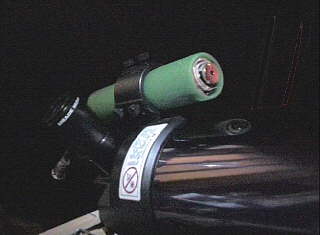K3PGP.Experimenter's.Corner
![]()
K3PGP.Experimenter's.Corner
![]()
Home Astronomy Bicycle Construction Laser Moonbounce Software Guest Misc Sales
Using
a green laser pen as a finder scope
Somehow this page got lost during an update. It's
now back!
 |
I have been experimenting with using a green laser
pen as a finder scope. The photo on the left is a frame from a video shot with a handheld consumer grade camcorder. This camcorder is not very sensitive and only shows very bright stars which is why the sky appears dark with only one star. I was at 10x optical zoom when this video was shot so the field of view is somewhat narrow. This was the only way I could get the camcorder to pick up the star image. The video was not enhanced in any way. The sparkle visible in the laser beam is due to water vapor in the air as it's rather humid here in the summer. The telescope was pointed slightly below the star to prevent the laser beam from covering the star. Needless to say there is NO DOUBT as to where the telescope is pointing! The laser is a green laser pen with remote switch from Atlas Nova. |
 |
I wrapped some cardboard around the laser pen and stuffed it into a piece of plastic tubing left over from a roll of plastic grocery bags. The type you see in the vegetable / fruit department. This was the first thing I found that was approx. the right diameter to fit in the finder mount. It's worked well enough that I haven't bothered to make any improvements. |
There has been some concern raised about using using a laser as a finder because of the light pollution the laser causes. While it can be extremely effective in allowing other telescopes to be pointed at the same object you are looking at (just follow the beam up into the sky from any other telescope and you will find the desired object at the end of the beam), or great for public demonstrations, it can be extremely frustrating to other telescope users if not used with caution as you could very easily sweep the laser through the field of view of another telescope taking a time exposure photograph. Especially disturbing when it occurs 44 minutes into a 45 minute exposure! It is for that reason I suggest you do NOT use this type of finder around fellow telescope users without their consent.
Fortunately this problem diminishes very rapidly as one leaves the location of the laser. What you are seeing is the laser light being scattered by water vapor, dust and other pollutants in the atmosphere. When you are standing near the telescope you are looking at a column of scattered light from the end view and as a result you see the maximum number of reflections concentrated into a small area. This effect diminishes VERY rapidly as you walk away from behind the telescope as the reflections then appear to be spread over a larger area meaning it is unlikely you are going to disturb anyone that is not in the immediate vicinity of your setup. Someone in the same parking lot? Most definitely YES! Someone on the other side of town? Unlikely.
As a side note, I have NOT found this to be the case during overcast nights when I am able to see the laser reflecting off the bottom of the cloud layer. In that case the laser is pretty much visible by anyone that can see the same area of the cloud layer.
Home Astronomy Bicycle Construction Laser Moonbounce Software Guest Misc Sales
Contents of this website are ©1995-2012 of K3PGP and of the originating authors.